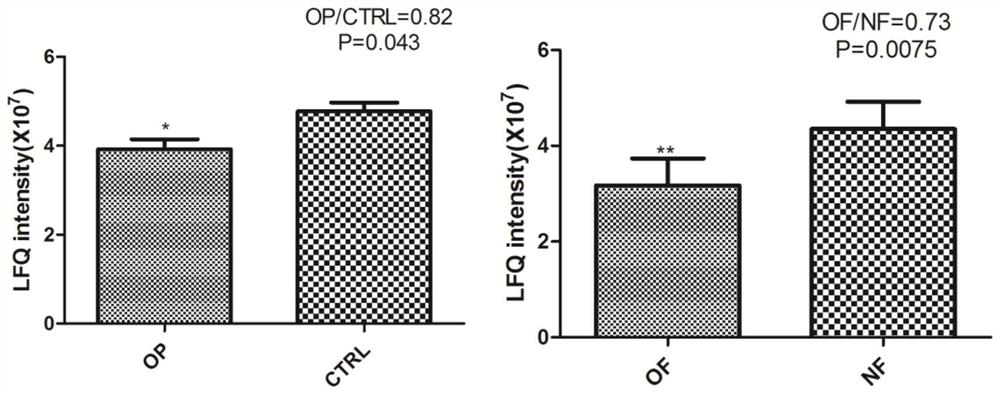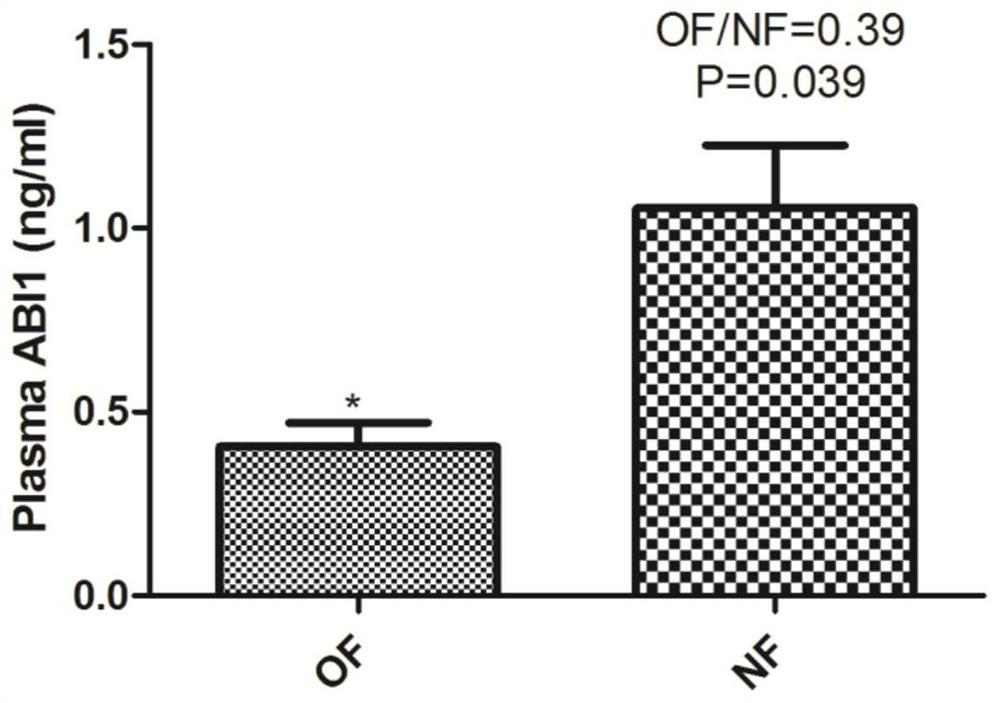A protein biomarker for the diagnosis of osteoporosis and its application
A biomarker and osteoporosis technology, applied in the field of protein biomarkers, can solve the problems of small OP heritability and unclear function of disease genes, and achieve excellent sensitivity and specificity
- Summary
- Abstract
- Description
- Claims
- Application Information
AI Technical Summary
Problems solved by technology
Method used
Image
Examples
Embodiment 1
[0029] Example 1: Screening of Dysregulated Proteins in Peripheral Blood Mononuclear Cells of Osteoporosis Patients (9:9)
[0030] 1. After obtaining informed consent, 9 patients with osteoporosis and 9 healthy individuals with bone were collected as normal controls. Fasting peripheral blood samples were collected and placed in sodium citrate anticoagulant tubes.
[0031] 2. Peripheral blood mononuclear cells were obtained by density gradient centrifugation and MACS positive sorting method, and the cell proteome was identified and quantified. Specific steps are as follows:
[0032] (1) Peripheral blood mononuclear cell isolation
[0033] 1. Add 15ml of density gradient separation solution to the leucosep tube, centrifuge at 100g for 1min.
[0034] 2. Pour the collected fresh whole blood into a 50ml centrifuge tube, add an equal amount of PBS and mix well, then transfer to a leucosep tube, and centrifuge at 310g for 20min.
[0035] 3. Aspirate and discard the remaining super...
Embodiment 2
[0080] Example 2: Screening of dysregulated proteins in peripheral blood mononuclear cells of patients with OF (18:18)
[0081] This example contains 18 OF patients and 18 controls with no history of fractures. Patients and controls were matched for age and sex. Peripheral blood was collected, blood mononuclear cells were isolated, total protein was extracted, enzyme digestion, identification and quantification, case-control differential analysis, identification of differentially expressed proteins.
[0082] The specific experiment and analysis method flow are the same as those in Example 1, and will not be repeated here. The analysis results showed that there was a significant difference in the expression level of ABI1 protein between the osteoporotic fracture group (OF) and the control group (NF) (P figure 2 (Right panel) shows dysregulated ABI1 protein expression in peripheral blood mononuclear cells of patients with osteoporotic fractures. As can be seen from the figure,...
Embodiment 3
[0083] Example 3: Validation of peripheral blood mononuclear cell protein markers in patients with osteoporosis
[0084] I. Identification of Osteoporosis Protein Markers
[0085] A total of 27 subjects were included in this example. Among them, 9 cases were individuals with normal bone density (CTRL), 9 cases were osteoporotic patients (OP), and 9 cases were osteoporotic fracture patients (OF). Peripheral blood was collected, blood mononuclear cells were separated, total cell protein was extracted, any three samples in the group were mixed as a small group, and the concentration was determined. The specific experiment and analysis method flow are the same as those in Example 1, and will not be repeated here.
[0086] image 3 The expression levels of ABI1 protein in peripheral blood mononuclear cells of individuals with normal bone density (CTRL), patients with osteoporosis (OP), and patients with osteoporotic fractures (OF) were significantly different (P=0.0053). It can...
PUM
| Property | Measurement | Unit |
|---|---|---|
| molecular weight | aaaaa | aaaaa |
Abstract
Description
Claims
Application Information
 Login to View More
Login to View More - R&D
- Intellectual Property
- Life Sciences
- Materials
- Tech Scout
- Unparalleled Data Quality
- Higher Quality Content
- 60% Fewer Hallucinations
Browse by: Latest US Patents, China's latest patents, Technical Efficacy Thesaurus, Application Domain, Technology Topic, Popular Technical Reports.
© 2025 PatSnap. All rights reserved.Legal|Privacy policy|Modern Slavery Act Transparency Statement|Sitemap|About US| Contact US: help@patsnap.com



